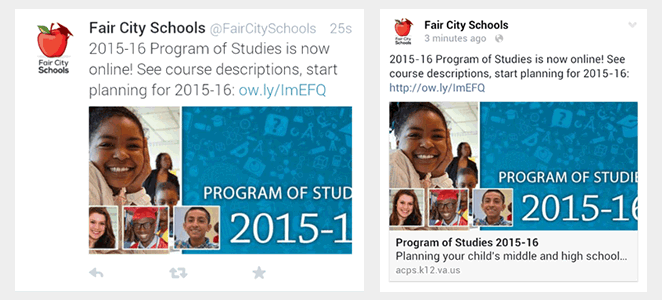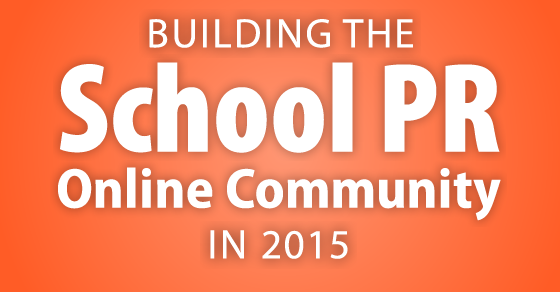More than 100 examples of award-winning #SchoolPR publications
If you’re looking for great examples of school district publications and electronic communications, look no further than the top winners of NSPRA’s Publications and Electronic Media Awards contest. Below are links (as many as I could find) to the 2015 Award of Excellence winners. Hope you’re inspired!
- Annual Report
- Branding/Image Package
- Calendar
- E-Newsletter (External Audience)
- E-Newsletter (Internal Audience)
- Excellence in Writing
- Finance Publication
- Handbook
- Internet/Intranet Website
- Magazine
- Marketing Materials (Electronic)
- Marketing Publication
- Print Newsletter (External Audience)
- Print Newsletter (Internal Audience)
- Social Media
- Special Purpose Publication
- Video (produced in-house)
- Video (produced with outside contract)
Annual Report
- Arlington Public Schools, Arlington, VA
2013-14 Annual Report - Dayton Public Schools, Dayton , OH
Dedication to Education: 2014 Report to the Community - Fort Worth ISD, Fort Worth, TX
Commitment to Classrooms / 2013-2014 Annual Report - Guilford County Schools, Greensboro, NC
2014 Annual Report: Power of the Dream [PDF] - Newton County School System, Covington, GA
2013-2014 Annual Report [PDF] - Orange County Public Schools, Orlando, FL
2014 Annual Report [PDF] - St. Charles Parish Public Schools, Luling, LA
2013-2014 Report to Our Community - Texas Association of School Boards, Austin, TX
TASB 2014 Annual Report
Branding/Image Package
- Anoka-Hennepin Schools Community Education, Anoka, MN
Anoka-Hennepin Community Education - Calgary Catholic School District, Calgary, AB
Run & Walk - Des Moines Public School, Des Moines, IA
School Welcome Banners [PDF] - Fairfax County Public Schools, Annadale, VA
Innovation Workshop: Building Discovery - Harlingen CISD, Harlingen, TX
Educating Innovators Every Day - Houston ISD, Houston, TX
Service Excellence: Improving Lives, Building Trust
Helen Spencer, Chief Communications Officer - Mesa Public Schools, Mesa, AZ
KinderU Preschool Branding Initiative - Montgomery County Public Schools, Christiansburg, VA
Mission and Vision Branding: Engage, Encourage, Empower - Parkway School District, Chesterfield, MO
Proposition S - Pearland ISD, Pearland, TX
Education Foundation Grown-Up Spelling Bee Fundraiser - Pulaski County Special SD, Little Rock, AR
"We Take Your Child’s Education Personally" Campaign - School District of Clayton, Clayton, MO
Educate. Inspire. Empower. Re-branding the School District of Clayton. - Socorro ISD, El Paso, TX
Leading, Inspring, Innovating - St. Charles Parish Public Schools, Luling, LA
Wonderland — Teachers of the Year Banquet - St. Charles Parish Public Schools, Luling, LA
Pulling Together — Every Child, Every Day - Texas Association of School Boards, Austin, TX
2015 TASA/TASB Convention
Calendar
- Columbia Heights Public Schools, Columbia Heights, MN
2014-2015 Calendar [PDF] - Millard Public Schools, Omaha, NE
Millard Public Schools — A District Choice! - North Allegheny School District, Pittsburgh, PA
2014-2015 Activities Calendar - Pulaski County Special SD, Little Rock, AR
PCSSD 2014-15 Directory/Calendar - Trillium Lakelands DSB, Lindsay, ON
Kindergarten Calendar - Utica City School District, Utica, NY
"Little Hands, Big Hearts" 2014-15 District Calendar [PDF] - White Bear Lake Area Schools, White Bear Lake, MN
2014-15 Activities Calendar [PDF]
E-Newsletter (External Audience)
- Des Moines Public School, Des Moines, IA
TheWeek@DMPS - Plano ISD, Plano, TX
Plano ISD eNews
E-Newsletter (Internal Audience)
- Fayetteville Public Schools, Fayetteville, AR
FPS This Week - North Allegheny School District, Pittsburgh, PA
NA Tiger News (October, 2014 and January, 2015 issues) - Plano ISD, Plano, TX
District Digest Electronic Employee Newsletter
Excellence in Writing
- Broadalbin-Perth Central Schools, Broadalbin, NY
B-P Students, Teachers Adjusting Well to Common Core - District School Board of Niagara, St. Catharines, ON
Director’s Welcome Back Speech to School Administrators - Guilford County Schools, Greensboro, NC
Fighting Back - Virginia Beach City Public Schools, Virginia Beach, VA
Compass Keepers Club: Debbie Cathey
Finance Publication
- Fairfax County Public Schools, Annadale, VA
Citizen’s Guide to Understanding the Budget [PDF]
Handbook
- Chesterfield County Public Schools, Chesterfield, VA
Every Day Counts! 2014-15 Parent Handbook [PDF] - Pasco School District #1, Pasco, WA
Welcome to Pasco Schools — Guide Book - Virginia Beach City Public Schools, Virginia Beach, VA
2014-2015 Elementary Handbook [PDF]
Internet/Intranet Website
- Cleveland Heights City School District, University Heights, OH
Cleveland Heights-University Heights CSD Website - Dalton Public Schools, Dalton, GA
Dalton Public Schools Website - Harlingen CISD, Harlingen, TX
Harlingen CISD Website - Houston ISD, Houston, TX
EMERGing Voices - Saint Paul Public Schools, Saint Paul , MN
School Marketing Toolkit - School District of Palm Beach County, West Palm Beach, FL
Superintendent Search Website - Simcoe County DSB, Midhurst, ON
School Websites Redesign — Ardagh Bluffs Public School - Texas Association of School Boards, Austin, TX
TASA/TASB Convention Website - Vancouver Public Schools, Vancouver, WA
Vancouver Public Schools Website
Magazine
- AASA, Alexandria, VA
School Administrator, November 2014 - Texas Association of School Boards, Austin, TX
Texas Lone Star - The Pingry School, Martinsville, NJ
The Pingry Review — December 2014 - The Pingry School, Martinsville, NJ
The Pingry Review — September 2014 - The Pingry School, Martinsville, NJ
The Pingry Review — March 2014 [PDF]
Marketing Materials (Electronic)
- Fort Worth ISD, Fort Worth, TX
Bass Hall Choral Camp PSA - Fort Worth ISD, Fort Worth, TX
JROTC Armed Forces PSA - Kennewick School District, Kennewick, WA
2015 Bond TV Commercial - Parkway School District, Chesterfield, MO
"This Is Parkway" Digital Magazine - School District of Palm Beach County, West Palm Beach, FL
Marketing Campaign
Marketing Publication
- Beaufort County School District, Beaufort, SC
Beaufort Community Report Card [PDF] - Edina Public Schools, Edina, MN
Learning for Life Fall 2014 Adult Catalog [PDF] - Fairfax County Public Schools, Annandale, VA
STEM-H EXPO Future Force - Noblesville Schools, Noblesville, IN
We Are Noblesville Schools [PDF] - Oneida-Herkimer-Madison BOCES, Utica, NY
2015-16 Program Guide - Orange County Public Schools, Orlando, FL
Expectation: Graduation - San Ramon Valley USD, Danville, CA
Come Work for Us Brochure - Texas Association of School Boards, Austin, TX
HR Services Brochure - Warwick Valley Central School District, Warwick, NY
See for Yourself
Print Newsletter (External Audience)
- Anoka-Hennepin School District, Anoka, MN
Focus Community Newsletter - Arlington Public Schools, Arlington, VA
The Citizen - Cleveland Heights City School District, University Heights, OH
Cleveland Heights-University Heights CSD UPDATE Newsletter - Fayetteville Public Schools, Fayetteville, AR
FPS News [PDF] - Parkway School District, Chesterfield, MO
"Parkway Today" Newsletter - School District of Clayton, Clayton, MO
Inside Clayton
Print Newsletter (Internal Audience)
- Arlington Public Schools, Arlington, VA
NewsCheck - Henrico County Public Schools, Henrico, VA
School Days News Quarterly - Mariemont City School District, Cincinnati, OH
The Experience - Staunton City Schools, Staunton, VA
The Student Advocate
Social Media
- Des Moines Public School, Des Moines, IA
Instagram Billboards - Fayetteville Public Schools, Fayetteville, AR
Fayetteville Public Schools Social Media - Kennewick School District, Kennewick, WA
2015 Bond Social Media Campaign - Lincoln Public Schools, Lincoln, NE
Social Media – Lincoln Public Schools
Special Purpose Publication
- Anoka-Hennepin School District, Anoka, MN
Visual Identity and Brand Book [PDF] - Arlington Public Schools, Arlington, VA
Infographic: Economic Impact of Arlington Public Schools [PDF] - Boulder Valley School District, Boulder, CO
2015 CMEA Conference Guide [PDF] - Des Moines Public School, Des Moines, IA
Education Fair Brochure [PDF] - District School Board of Niagara, St. Catherines, ON
Bringing Harriet Home Fundraiser Campaign - District School Board of Niagara, St. Catharines, ON
Oliver’s Big Bump — Concussion Education Resource for Schools - Fairfax County Public Schools, Annandale, VA
Supporting Excellence in Public Education - Gwinnett County Public Schools, Suwanee, GA
Quality-Plus Mathematical Strategies and Practices Posters (ES, MS, HS, and Translations) - Harlingen CISD, Harlingen, TX
Thank You, Retirees - Harlingen CISD, Harlingen, TX
Congratulations Top 10 Graduates Billboard — 2014 - Highland Park ISD, Dallas, TX
Highland Park Commemorative Centennial Book: Celebrating 100 years of excellence in learning and service - Howard-Suamico School District, Green Bay, WI
Upward Together Education Campaign - Marion County Public Schools, Ocala, FL
District Snapshot - Mobile County Public School System, Mobile, AL
It Starts with Us Newspaper Insert - Mt. Lebanon School District, Pittsburgh, PA
Century of Excellence (Capital Campaign Brochure) - Newport News Public Schools, Newport News, VA
NNPS Engineering Design Challenge: A Mystery Trapped in History - Oneida-Herkimer-Madison BOCES, Utica, NY
2015-16 Service Directory [PDF] - Oneida-Herkimer-Madison BOCES, Utica, NY
What Employers Expect - Peel District School Board, Mississauga, ON
Making My Way — Pathways for All Students - Pittsford Central School District, Pittsford, NY
The KEEP Foundation "Give to KEEP" Postcard - Rockwood School District, Wildwood, MO
Strategic Plan: 2014-2019 [PDF] - San Ramon Valley USD, Danville, CA
SRVUSD Informational Brochure - School District of Clayton, Clayton, MO
Brand Standards - Simcoe County DSB, Midhurst, ON
Mental Health Matters [PDF] - Socorro ISD, El Paso, TX
SISD Operation College Bound [PDF] - Vancouver Public Schools, Vancouver, WA
Design II, Chapter 2 Strategic Plan [PDF]
Video (produced in-house)
- Arlington Public Schools, Arlington, VA
APS Green Scene - Bethel School District, Spanaway, WA
Kapowsin Elementary Community Garden - Blue Valley School District 229, Overland Park, KS
"HIGH-FIVE BV" — Maggie Hettinger Feature Video - Broken Arrow Public Schools, Broken Arrow, OK
Here We Grow 2015 Bond Election Video - Clarksville Montgomery CSS, Clarksville, TN
Graduation 2014 - Clarksville Montgomery CSS, Clarksville, TN
Trisha Fields Spotlight - Des Moines Public School, Des Moines, IA
Social Media at DMPS - Fairfax County Public Schools, Falls Church, VA
FCPS News Hour #10 - Kent School District, Kent, WA
Kent School District IT Department: "A Strategic Partner in Education" - Leander ISD, Leander, TX
Inside Leander - Minnetonka Public Schools, Minnetonka, MN
Minnetonka Success: Frank Kuzma - Minnetonka Public Schools, Minnetonka, MN
Minnetonka Schools Foundation: Who Will? - Pittsford Central School District, Pittsford, NY
Mendon High School Bobblehead Balloon Launch Video - Plano ISD, Plano, TX
Summer Renovations - Plano ISD, Plano, TX
Academy High School Information Video 2014 - Socorro ISD, El Paso, TX
#TeamSISD — The Tomlinson Family - Sunnyside School District, Sunnyside, WA
Inspired: Mrs. Barrom - Tempe Elementary Schools, Tempe, AZ
Believe Video - Virginia Beach City Public Schools, Virginia Beach, VA
Compass Keepers Series - White Bear Lake Area Schools, White Bear Lake, MN
New Principal Video Series
Video (produced with outside contract)
- Champaign Unit 4 Schools, Champaign, IL
U4 Innovate Video - Kennewick School District, Kennewick, WA
2015 Bond Video - Oklahoma State School Boards Association, Oklahoma City, OK
For the People - Virginia Beach City Public Schools, Virginia Beach, VA
Compass to 2020 Strategic Plan
 As school PR pros, we understand we can’t cover every good story going on in our districts. The beauty of social media, however, is that everyone is now empowered as a broadcaster, and there are scores of school and district brand ambassadors out there sharing the good stories to their own followers. By tapping into the crowdsourced content created by teachers, PTAs, parents, student groups and alumni, we share their good news to a larger crowd and keep our social media feeds fresh.
As school PR pros, we understand we can’t cover every good story going on in our districts. The beauty of social media, however, is that everyone is now empowered as a broadcaster, and there are scores of school and district brand ambassadors out there sharing the good stories to their own followers. By tapping into the crowdsourced content created by teachers, PTAs, parents, student groups and alumni, we share their good news to a larger crowd and keep our social media feeds fresh. There’s something extra engaging about sharing photos of an event live on your Twitter feed. However, the tool you use to send those tweets — your phone — doesn’t have the best possible camera or lens, especially if you’re taking photos of quickly moving children in bad lighting.
There’s something extra engaging about sharing photos of an event live on your Twitter feed. However, the tool you use to send those tweets — your phone — doesn’t have the best possible camera or lens, especially if you’re taking photos of quickly moving children in bad lighting.


 Do any of your schools run their own separate, but official Twitter accounts? What about PTAs and student groups? It’s likely that the people who are interested in the schools and therefore follow those accounts would also be interested in information from the district level. But perhaps they don’t know your account exists.
Do any of your schools run their own separate, but official Twitter accounts? What about PTAs and student groups? It’s likely that the people who are interested in the schools and therefore follow those accounts would also be interested in information from the district level. But perhaps they don’t know your account exists.


